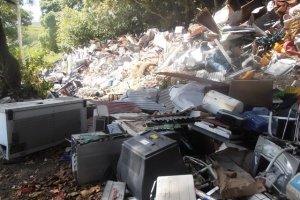Seychelles exploring waste-to-energy strategy to reduce dependence on limited landfills
General |Author: Salifa Karapetyan Edited by: Betymie Bonnelame | December 10, 2018, Monday @ 16:03| 14972 views
A waste-to-energy plant can reduce the amount of waste ending up on the landfill by up to 90 percent. (Seychelles News Agency)
(Seychelles News Agency) - The Seychelles’ environment ministry is looking into the possibility of building a waste-to-energy plant and having a more sustainable waste management strategy, a top official said on Monday.
A waste-to-energy plant is a facility that produces clean and renewable energy through the combustion of municipal waste; it can reduce the amount of waste by up to 90 percent, the remaining of which is disposed of in landfills.
“By the end of the month or early next year we will make it possible for the private sector, both local and international, or even jointly, for any interested party to submit their expression of interest to invest in a waste-to-energy plant or facility in the country,” said Alain Decommarmond, the principal secretary of environment.
Decommarmond added that an area has already been identified for the potential plant at Providence, where the two landfills are located. With land being scarce in Seychelles -- a 115-island archipelago in the western Indian Ocean -- the government has been looking at ways to reduce waste.
The waste-to-energy plant is one of the strategies the Ministry of Environment is looking into under the newly endorsed National Waste Policy for the next five years -- 2018 to 2023. The main goal of the policy is to manage waste in a sustainable manner in order to protect the environment and improve the quality of life in Seychelles.
“Waste management is a top priority for the Ministry of Environment as it touches all aspects in the country, including economic, social and the protection of the environment,” said Decommarmond.
Approved by the Cabinet of Ministers last week, the policy also addresses the handling and disposal of all waste including hazardous and electronic waste.
One strategy to help reduce the amount of waste generated in the country is to restrict certain products from coming into the country, especially when importers have the option to bring in more environmentally friendly alternatives.
“We have clearly outlined that the responsibility to deal with waste is not solely the responsibility of the government or the authority. The importer bringing in the commodity has to also think of how to contribute towards getting rid of the waste,” said Decommarmond.
He added that this will be facilitated and guided through strategies that the government will put in place. The waste can either be managed locally or a system can be put in place where the waste will be collected and exported.
“The policy also looks at opportunities to recycle or redeem some waste and it is important to work with the private sectors to export them,” added Decommarmond.
According to the Seychelles Sustainable Development Strategy (2012-2020), the 95,000 inhabitants of the island nation generates about 48,000 tonnes of waste per year.
Back
